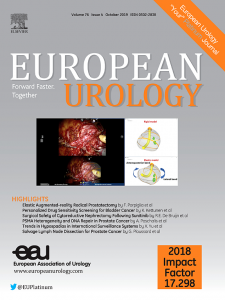LEA随机试验的长期结果:接受根治性膀胱切除术的膀胱癌患者的扩展淋巴结清扫与标准淋巴结清扫
IF 25.2
1区 医学
Q1 UROLOGY & NEPHROLOGY
引用次数: 0
摘要
膀胱癌(BC)根治性膀胱切除术(RC)时淋巴结清扫(LND)的程度可能影响肿瘤预后。我们提供了一项前瞻性、多中心、3期试验的最新长期数据,该试验涉及未经新辅助治疗的局部可切除、高风险T1级3级或肌肉侵袭性尿路上皮性BC (T2-T4a M0)患者(试验LEA AUO AB 25/02; NCT01215071)。共有401例患者被随机按1:1分配到标准LND (sLND:闭孔、内、外髂淋巴结)或扩展LND (eLND),其中还包括深闭孔、髂总、骶前、腔旁、腹主动脉间和主动脉旁淋巴结,直至肠系膜下动脉。无疾病复发存活患者的中位随访时间为58.4个月。主要终点为无复发生存期(RFS)。总生存期(OS)和癌症特异性生存期(CSS)是次要终点。eLND在RFS(5年率:68% vs 60%;风险比[HR] 0.80, 95%可信区间[CI] 0.56-1.14; p = 0.2)和OS(5年率:57% vs 51%; HR 0.84, 95% CI 0.64-1.12; p = 0.2)方面没有显示出sLND的优势。eLND组的CSS发生率明显更高(5年发生率:76% vs 65%; HR 0.65, 95% CI 0.43-0.96; p = 0.031),具有临床意义。在长期随访中,该随机对照试验的主要终点RFS为阴性,但CSS为阳性。因此,使用至少一个标准模板的细致LND仍然是BC患者接受RC的推荐手术入路。本文章由计算机程序翻译,如有差异,请以英文原文为准。
Long-term Results from the LEA Randomized Trial: Extended Versus Standard Lymph Node Dissection in Patients with Bladder Cancer Undergoing Radical Cystectomy
The extent of lymph node dissection (LND) at the time of radical cystectomy (RC) for bladder cancer (BC) may affect oncologic outcomes. We present updated long-term data from a prospective, multicenter, phase 3 trial involving patients with locally resectable, high-risk T1 grade 3 or muscle-invasive urothelial BC (T2–T4a M0) without neoadjuvant treatment (trial LEA AUO AB 25/02; NCT01215071). A total of 401 patients were randomly assigned 1:1 to either standard LND (sLND: obturator, internal, and external iliac nodes) or extended LND (eLND), which also included the deep obturator, common iliac, presacral, paracaval, interaortocaval, and para-aortic nodes up to the inferior mesenteric artery. Median follow-up for patients alive without disease recurrence was 58.4 mo. The primary endpoint was recurrence-free survival (RFS). Overall survival (OS) and cancer-specific survival (CSS) were secondary endpoints. eLND failed to show superiority over sLND for RFS (5-yr rate: 68% vs 60%; hazard ratio [HR] 0.80, 95% confidence interval [CI] 0.56–1.14; p = 0.2) and OS (5-yr rate: 57% vs 51%; HR 0.84, 95% CI 0.64–1.12; p = 0.2). The CSS rate was significantly higher in the eLND arm (5-yr rate: 76% vs 65%; HR 0.65, 95% CI 0.43–0.96; p = 0.031), which is clinically meaningful. With long-term follow-up, this randomized controlled trial remains negative for the primary endpoint of RFS, but was positive for CSS. Therefore, meticulous LND using at least a standard template remains the recommended surgical approach for patients undergoing RC for BC.
求助全文
通过发布文献求助,成功后即可免费获取论文全文。
去求助
来源期刊

European urology
医学-泌尿学与肾脏学
CiteScore
43.00
自引率
2.60%
发文量
1753
审稿时长
23 days
期刊介绍:
European Urology is a peer-reviewed journal that publishes original articles and reviews on a broad spectrum of urological issues. Covering topics such as oncology, impotence, infertility, pediatrics, lithiasis and endourology, the journal also highlights recent advances in techniques, instrumentation, surgery, and pediatric urology. This comprehensive approach provides readers with an in-depth guide to international developments in urology.
 求助内容:
求助内容: 应助结果提醒方式:
应助结果提醒方式:


